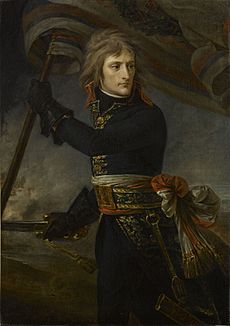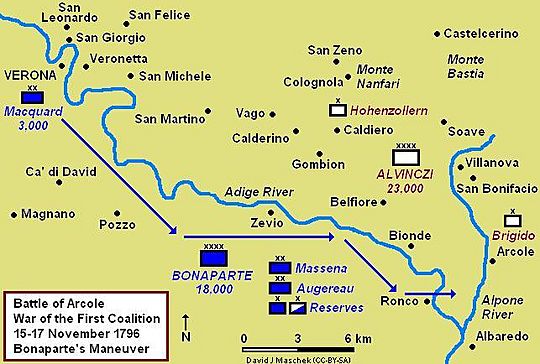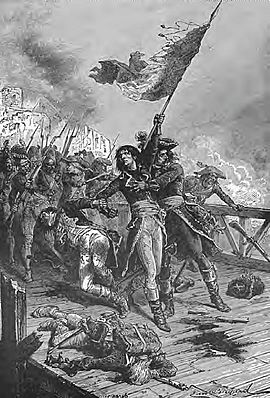Battle of Arcole facts for kids
Quick facts for kids Battle of Arcole |
|||||||
|---|---|---|---|---|---|---|---|
| Part of the Italian campaigns in the War of the First Coalition | |||||||
 Napoleon Bonaparte leading his troops over the bridge of Arcole, by Horace Vernet |
|||||||
|
|||||||
| Belligerents | |||||||
| Commanders and leaders | |||||||
| Strength | |||||||
| 20,000 | 24,000 | ||||||
| Casualties and losses | |||||||
| 3,500 killed or wounded 1,300 captured |
2,200 killed or wounded 4,000 captured |
||||||
The Battle of Arcole (November 15–17, 1796) was a major fight between French and Austrian armies. It happened about 25 kilometers (15 miles) southeast of Verona, Italy. This battle was part of the War of the First Coalition, which was a bigger conflict during the French Revolutionary Wars.
In this battle, Napoleon Bonaparte led his French Army of Italy in a clever move. He tried to get around the Austrian army, led by General József Alvinczi, to cut off their escape route. The French won, and this victory was very important. It stopped the Austrians from helping their friends who were stuck in the city of Mantua.
General Alvinczi had planned a two-part attack against Napoleon's army. One Austrian group, led by General Paul Davidovich, was to move south along the Adige River. Alvinczi himself would lead the main army from the east. Their big goal was to free the Austrian soldiers trapped in Mantua. If they succeeded, it would be very bad for the French.
Davidovich won a battle against the French General Claude-Henri Belgrand de Vaubois at Calliano. This meant he was getting close to Verona from the north. Meanwhile, Alvinczi pushed back Napoleon's first attack at Bassano. He then advanced close to Verona, where he defeated another French attack at Caldiero.
Napoleon left Vaubois' tired soldiers to keep Davidovich busy. Then, he gathered all his other troops. He tried to sneak around Alvinczi's left side by crossing the Adige River. For two days, the French attacked the strong Austrian defenses at Arcole, but they couldn't break through. Finally, on the third day, their constant attacks forced Alvinczi to retreat.
On that same day, Davidovich defeated Vaubois, but it was too late. Napoleon's win at Arcole allowed him to focus on Davidovich and chase him away. Alvinczi tried to threaten Verona again, but without Davidovich's help, he was too weak. He had to retreat again. The Austrian commander in Mantua, Dagobert Sigmund von Wurmser, tried to break out, but it was too late in the campaign to make a difference. The Austrians' third attempt to rescue Mantua failed, but it was a very close call.
Contents
Background to the Battle
Armies and Plans
The second attempt to help the city of Mantua had failed for Austria. General Napoleon Bonaparte had defeated General Dagobert Sigmund von Wurmser's army at the Battle of Bassano. Wurmser managed to reach Mantua with 16,000 soldiers. But the French pushed him into the city, where he and the existing soldiers were trapped. Sickness and hunger started to affect them badly.
The Austrian Emperor Francis II of Austria chose General József Alvinczi to lead a new army. This army would make a third attempt to free Mantua. Alvinczi and his generals planned a two-part attack. One group, called the Friaul Corps, would move west towards Verona. The other group, the Tyrol Corps, would come south from the Alps to meet them. General Wurmser, trapped in Mantua, was supposed to break out and attack the French from behind.
Alvinczi's Friaul Corps had about 26,000 soldiers. They moved west from the Piave River towards Mantua. General Paul Davidovich's Tyrol Corps had about 19,000 soldiers. Another 3,000 Austrian soldiers connected these two main groups.
Napoleon had his forces spread out. General Claude-Henri Belgrand de Vaubois had 10,500 men watching Davidovich. General André Masséna's 9,540 soldiers were defending the Brenta River. General Pierre Augereau's 8,340 troops were along the Adige River. General Charles Edward Jennings de Kilmaine had 8,830 soldiers blocking Mantua. Napoleon also had reserves near Verona.
The Austrians tried hard to hide how strong Davidovich's army was. Napoleon even ordered Vaubois to attack Davidovich, thinking he could easily win. On November 2, Vaubois attacked Davidovich near Cembra. The French lost 650 men, but the Austrians lost over 1,100. Still, the French had to retreat to Calliano the next day.
Early Battles
On November 1, Alvinczi's Friaul Corps began crossing the Piave River. Napoleon decided to attack the Austrians on the Brenta. He called Augereau and his reserves to join Masséna. In the Second Battle of Bassano on November 6, the Austrians fought off Napoleon's attacks. The French lost about 3,000 men, while the Austrians lost around 2,800. Napoleon quickly pulled his troops back to Verona.

Davidovich attacked Vaubois at the Battle of Calliano on November 6. The French fought hard but were pushed back. On November 7, Davidovich attacked again. Vaubois' soldiers eventually panicked and ran away. Between November 2 and 7, Vaubois' division lost 4,400 men and six cannons. The Austrians also lost many men. Napoleon was very angry about his soldiers' poor performance.
Austrian commanders had trouble communicating with each other because their armies were so far apart. Also, many of Alvinczi's soldiers were new recruits and struggled to keep up. Alvinczi kept telling Davidovich to hurry towards Verona.
Alvinczi's advance guard, led by General Hohenzollern, moved towards Verona. On November 11, they met Masséna near the city and had to retreat. On November 12, in a sleet storm, Hohenzollern fought off attacks from Masséna and Augereau in the Battle of Caldiero. When more Austrian soldiers arrived, Napoleon stopped his attacks and pulled his troops back into Verona. The Austrians lost over 1,200 men, and the French lost about 1,800.
Napoleon's Bold Plan
After two tough defeats, Napoleon was worried. He left some troops to defend Verona and Vaubois' tired soldiers to keep Davidovich busy. General Kilmaine continued to block Mantua with fewer men. This left Napoleon with about 18,000 soldiers to face Alvinczi's main force of 23,000.
Napoleon had to be very careful. If Davidovich or Wurmser attacked strongly, he might have to stop his plans against Alvinczi. Losing any part of his army could mean disaster.
Unknown to the French, Alvinczi planned to build a bridge across the Adige River near Zevio on November 15. Meanwhile, Napoleon decided on a very daring plan. He quickly marched Masséna and Augereau along the west bank of the Adige River. They went to a place called Ronco all'Adige, which was behind Alvinczi's left side. Once his army crossed the river, Napoleon planned to move north. His goal was to cut off the Austrian escape route and capture their supplies and cannons.
The area on the other side of the river was marshy, meaning it was very wet and muddy. Soldiers couldn't easily move through it. All movement was limited to raised roads called causeways or dikes. These dikes ran along the Adige River and a smaller river called the Alpone. The Alpone was only about 20 meters (20 yards) wide and 1.5 meters (5 feet) deep. Napoleon hoped this difficult terrain would give his French soldiers an advantage. Also, the narrow battlefield meant the Austrians couldn't use their larger numbers effectively.
From Ronco, the road going north followed a dike for about 2.4 kilometers (1.5 miles) to a bridge. On the east side of this bridge was the village of Arcole. From there, the road continued north along the Alpone River to San Bonifacio. The dikes near Arcole were very high, about 8 meters (26 feet) tall, with steep sides. Another road followed a dike from Ronco northwest to Belfiore and then to Caldiero.
The Battle of Arcole
Day One
By dawn on November 15, Napoleon's troops reached the crossing point. Soon, his engineers had a floating bridge ready. Augereau's division crossed first and headed east and north towards Arcole. Masséna's soldiers followed. To protect the left side, they took a causeway leading north and west towards Belfiore di Porcile.
Alvinczi had placed four battalions (groups of soldiers) in the area. Two of these, with two cannons, defended Arcole. These Austrian troops pushed back Augereau's leading soldiers. Most of the French soldiers had to lie down behind the causeway to avoid the intense enemy fire. Augereau sent in more troops, but many of his generals were wounded, and the attack stopped completely.
On the western side, Alvinczi sent two brigades to capture the French floating bridge. They met Masséna near Bionde. At first, the Austrians were successful, but then they accidentally fired on their own men, causing panic. They were pushed back beyond Belfiore. The French watched as Austrian supply wagons rolled away on the main highway, out of their reach.
To break the deadlock near Arcole, Napoleon ordered General Jean Joseph Guieu to cross the Adige River further south. He also sent a French battalion across the Alpone River by boat. This unit fought its way north along the eastern dike.
Napoleon tried to inspire his men to attack. He grabbed a flag and stood out in the open on the dike, about 50 meters (55 paces) from the bridge. Amazingly, he wasn't hit, but several of his staff were, and his aide, Jean-Baptiste Muiron, was killed. An unknown officer pulled Napoleon out of the line of fire, and he ended up in a muddy ditch.
To make things more confusing, the Austrians attacked from Arcole and defeated the French battalion on the east bank. In the evening, General Guieu finally managed to push the Austrian defenders out of Arcole. But at midnight, Napoleon worried that Davidovich might attack his rear. So, he pulled most of his troops back across the Adige River, leaving only a small group to hold the bridgehead.
Day Two
Alvinczi left some troops near Verona to guard against an attack from that city. He ordered General Provera with six battalions to attack from Belfiore. Alvinczi also sent more troops to General Mittrowsky, giving him 14 battalions. Mittrowsky was told to advance south from Arcole. Both forces were to march at dawn on November 16 and meet at the French bridgehead. Alvinczi also sent two battalions to guard Albaredo.
Provera's attack failed when he ran into Masséna. An Austrian general was killed, and the Austrians were chased back to Belfiore, losing five cannons. During the morning, Mittrowsky and Augereau fought back and forth. In the end, the Austrians fell back to Arcole.
Mittrowsky placed his soldiers cleverly, blocking Napoleon's repeated attempts to capture the village. French attempts to cross the rivers at other points also failed. At nightfall, Napoleon pulled Masséna and Augereau back towards the bridgehead, but some French forces remained on the Austrian side of the Adige.
A brave French cavalry lieutenant, Joseph Hercule Domingue, was promoted to captain. Napoleon gave him a special sword for his surprise attack on the Austrian cavalry that day.
Day Three
On November 17, Alvinczi moved Hohenzollern's troops closer to his main army. Again, Provera held Belfiore, and Mittrowsky defended Arcole. During the night, Napoleon's engineers built a bridge across the Alpone River near its mouth. Augereau's division crossed this bridge and began fighting along the eastern dike. A French battalion and some cavalry also joined Augereau later in the day. Meanwhile, two of Masséna's brigades attacked along the western dike.
By early afternoon, Masséna defeated Provera near Belfiore again. Alvinczi called both Provera and Hohenzollern back towards the east. He started sending some of Hohenzollern's troops to help at Arcole. The battle there went back and forth all day. At 3:00 PM, a large group of Austrian soldiers attacked from Arcole and pushed back the French. Augereau's men on the east bank also fell back. By 4:00 PM, Augereau's tired division pulled back across the floating bridge to the west bank.
Just when it seemed the French would lose, Masséna arrived with more soldiers from the western side. He ambushed the Austrians on the western dike, sending them running back towards Arcole. Encouraged, Augereau's men crossed back to the east bank of the Alpone and rejoined the fight. Masséna and Augereau finally fought their way into Arcole around 5:00 PM. A lieutenant and 25 Guides (elite soldiers) helped the final attack. They rode into the Austrian rear and blew several bugles, making the Austrians think a large force was attacking them. The French then pushed north, threatening to block the main highway. Alvinczi sent in more troops to hold off the French, which allowed Provera's division to escape to the east.
Aftermath
The French lost about 3,500 soldiers killed or wounded, and 1,300 captured or missing at Arcole. The Austrians lost 2,200 killed or wounded, but 4,000 men and 11 cannons were captured. On the French side, General Jean Gilles André Robert was badly wounded and later died. Austrian General Gerhard Rosselmini also died.
On November 17, Davidovich finally attacked Vaubois at Rivoli. The French were pushed back and eventually panicked. The French lost 800 killed or wounded, and 1,000 captured. Austrian losses were 600. Vaubois retreated, and Davidovich followed. Napoleon sent his cavalry to watch Alvinczi's retreat. He then turned most of his forces towards Davidovich.
On November 19, Davidovich heard about the Austrian defeat at Arcole. He also saw signs that Napoleon was about to attack him with his full army. Davidovich pulled back to Rivoli on the 20th and started to retreat further the next morning. But then he received a message from Alvinczi telling him to stop. However, the French caught up with him at Rivoli. In the fight, the French lost 200 men, while the Austrians lost 250 killed or wounded. Another 600 Austrians, three cannons, and a bridge-building train were captured by the French. Davidovich quickly retreated north. Overall, Davidovich's retreat from Rivoli cost him about 1,500 men and nine cannons.
After Arcole, Alvinczi pulled back to Olmo. On November 18, his generals decided to return to the fight with their remaining 16,000 troops. By November 21, Alvinczi was back in Caldiero but couldn't go any further. While there, he heard about Davidovich's defeat on November 23. That evening, the Austrian army began its retreat.
During the three days of the Battle of Arcole, people in Mantua could hear the cannons. Observers in the fortress even noticed that some French camps seemed empty. Yet, General Wurmser, who was trapped in Mantua, did not act. On November 23, Wurmser attacked the French siege lines, capturing 200 Frenchmen and damaging some defenses. The Austrians lost almost 800 men. When he learned that Davidovich was retreating, Wurmser pulled back into the city.
In November 1796, the French took control of Venice and two large warships that were being built there. One of these warships was named the Muiron. This was to honor Bonaparte's aide, Jean-Baptiste Muiron, who was killed next to him on November 15. Later, when Napoleon returned from Egypt in 1799, he used the Muiron to escape to France.
Images for kids





